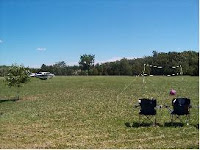On 5/19/08 I flew from
3SQ to
KSUS to practice the NDB RWY 8R approach. Before I list the steps I took to complete it, I'd like to list various notes regarding NDBs.
1. Homing: Tracking to an NDB by keeping the ADF needle centered at the top of the display will take you directly to the NDB. Getting to the NDB in this case is not by tracking any specific course.
2. To intercept and track magnetic bearings directly to and from an NDB (as in the
KSUS NDB RWY 8R approach) :
a. turn to inbound course heading 256
b. ADF needle is pointing to the nose of the display while heading 256
3. To know your tracking directly along the 256 degree radial:
a. when heading 256, ADF needle is pointing to right, then you're parallel and right of course
b. when heading 256, ADF needle is pointing to left, then you're parallel and left of course
4. Making corrections to get back on course you must double your corrections with wind/no wind situations:
Example for TO the NDBa. If head of ADF needle is 20 degrees left, turn 40 degrees left.
b. When needle head is to the right 40 degrees from where it was off, you're back on course.
c. Turn back to course heading, 256
Example for FROM the NDBa. If tail of ADF needle is 20 degrees left, turn 40 degrees right.
b. When needle tail is to the right 40 degrees from where it was off, you're back on course.
c. Turn back to course heading, 256
OR to simplify things for the FROM...Look at the head of the needle (points at tail once flown over the NDB)and make corrections the same as TO.
5. Interpolate winds on ground and at 3000 ft for approaches. Adjust approach time accordingly. For this approach I added ~12 seconds for the winds increasing my time from FAF to MAP from 3:28 to 3:40.
Flying the NDB RWY 8R approach at KSUSPreflight CompleteUp to Takeoff-Set Altimeter to reported Alt or airport elevation
-Set DG before and after starting the engine
-Master switch and avionics on
Comm 1 123.0 CTAF
3SQComm 1 126.5 STL approach in standby position
Comm 2 134.8 ATIS
Comm 2 124.75 Spirit Tower in standby position
ADF to 326
DME to 117.4 if have one in plane
-Avionics/Master Switch off - Start engine
Me: St. Charles Muni Traffic, N# ramp to 09
-Complete Run-up at holding position for 09
-TILT completed:
Time,
Instruments Set,
Lights on for takeoff,
Transponder to ALT
Me: St. Charles Muni Traffic, N# departing 09 Southwest
-Back taxi 09, turn to position and
takeoff.
Flight-At 800 turn L crosswind, then L downwind, depart pattern heading 240 and climb to 1500 ft to remain under Class B.
-Listen to ATIS by pressing Comm 2 receiving button
-toggle Comm 1 and Comm 2 frequencies to 126.5 STL approach and 124.75 Tower
Me: St. Louis Approach N#
ATC: N# go ahead
Me: N#, at 1500 for 2400 5 miles NE, request practice approach NDB RWY 8R at Spirit w/info Alpha
ATC: N# squawk 0234 & ident
Me: N# 0234 (tune in 0234 & press the ident button)
-At that point I climbed to 2400, making heading changes as received from St. Louis Approach.
-ID'd NDB by pushing ADF button and turning up volume keeping loud enough to hear it throughout the approach making sure it continued to work.
ATC: Cleared for
KSUS NDB 8R approach, contact tower on 124.75
Me: Cleared for
KSUS NDB 8R, tower 124.75
-Once on ~30 degree intercept, dial ADF to current heading. When ADF needle points to inbound course 076 at nose, turn to that heading and redial ADF to 076.
-Watched head of needle. When 10 degrees to left, doubled it and turned 20 degrees left. When head of needle moved 20 degrees right from where it was, turned back to inbound course 076.
Me: Spirit Tower, N# outside SNOOP
Tower: N#, Report SNOOP
Me: N#, Report SNOOP
-Continued to make adjustments in heading as needed, keeping on course
-Observed ADF needle flipped to point behind me
Me: N#, at SNOOP
-Turn, Tune, Time, Throttle, Talk & GMC (Gas on, Mixture rich, Carb heat on) : There weren't any turns or tuning at this time, I started my time, pulled the throttle to 1500 RPMs/90 Kts for approach speed, decending at 500 fpm to 1200 ft MDA.
Tower: On missed, turn left heading 080
Me: On missed, Left for 080, N#
-At 1200 ft, leveled off, waited out the time to adjusted time of 3:40
-Missed by full throttle/carb heat off, runway heading 080 to 1500
Me: Spirit Tower, N# missed
At this point, I was vectored for the same approach for the second time, cleared for the option which allowed me to complete a "touch and go" and then headed back to
3SQ. I logged 1.1 flight hours during this flight.
 I practiced the NDB RWY 8R on my MS Flight Sim tonight.
I practiced the NDB RWY 8R on my MS Flight Sim tonight. On 8/18/08, I practiced flying a DME ARC and 2 HOLDS:
On 8/18/08, I practiced flying a DME ARC and 2 HOLDS:





+024.jpg)
+042.jpg)
+022.jpg)









